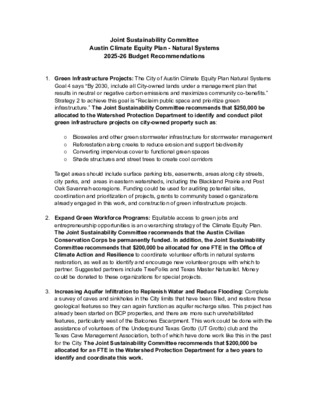7b. Natural Systems Budget Recommendations - DRAFT — original pdf
Backup

Joint Sustainability Committee Austin Climate Equity Plan - Natural Systems 2025-26 Budget Recommendations 1. Green Infrastructure Projects: The City of Austin Climate Equity Plan Natural Systems Goal 4 says “By 2030, include all City-owned lands under a management plan that results in neutral or negative carbon emissions and maximizes community co-benefits.” Strategy 2 to achieve this goal is “Reclaim public space and prioritize green infrastructure.” The Joint Sustainability Committee recommends that $250,000 be allocated to the Watershed Protection Department to identify and conduct pilot green infrastructure projects on city-owned property such as: ○ Bioswales and other green stormwater infrastructure for stormwater management ○ Reforestation along creeks to reduce erosion and support biodiversity ○ Converting impervious cover to functional green spaces ○ Shade structures and street trees to create cool corridors Target areas should include surface parking lots, easements, areas along city streets, city parks, and areas in eastern watersheds, including the Blackland Prairie and Post Oak Savannah ecoregions. Funding could be used for auditing potential sites, coordination and prioritization of projects, grants to community based organizations already engaged in this work, and construction of green infrastructure projects. 2. Expand Green Workforce Programs: Equitable access to green jobs and entrepreneurship opportunities is an overarching strategy of the Climate Equity Plan. The Joint Sustainability Committee recommends that the Austin Civilian Conservation Corps be permanently funded. In addition, the Joint Sustainability Committee recommends that $200,000 be allocated for one FTE in the Office of Climate Action and Resilience to coordinate volunteer efforts in natural systems restoration, as well as to identify and encourage new volunteer groups with which to partner. Suggested partners include TreeFolks and Texas Master Naturalist. Money could be donated to these organizations for special projects. 3. Increasing Aquifer Infiltration to Replenish Water and Reduce Flooding: Complete a survey of caves and sinkholes in the City limits that have been filled, and restore those geological features so they can again function as aquifer recharge sites. This project has already been started on BCP properties, and there are more such unrehabilitated features, particularly west of the Balcones Escarpment. This work could be done with the assistance of volunteers of the Underground Texas Grotto (UT Grotto) club and the Texas Cave Management Association, both of which have done work like this in the past for the City. The Joint Sustainability Committee recommends that $200,000 be allocated for an FTE in the Watershed Protection Department for a two years to identify and coordinate this work.